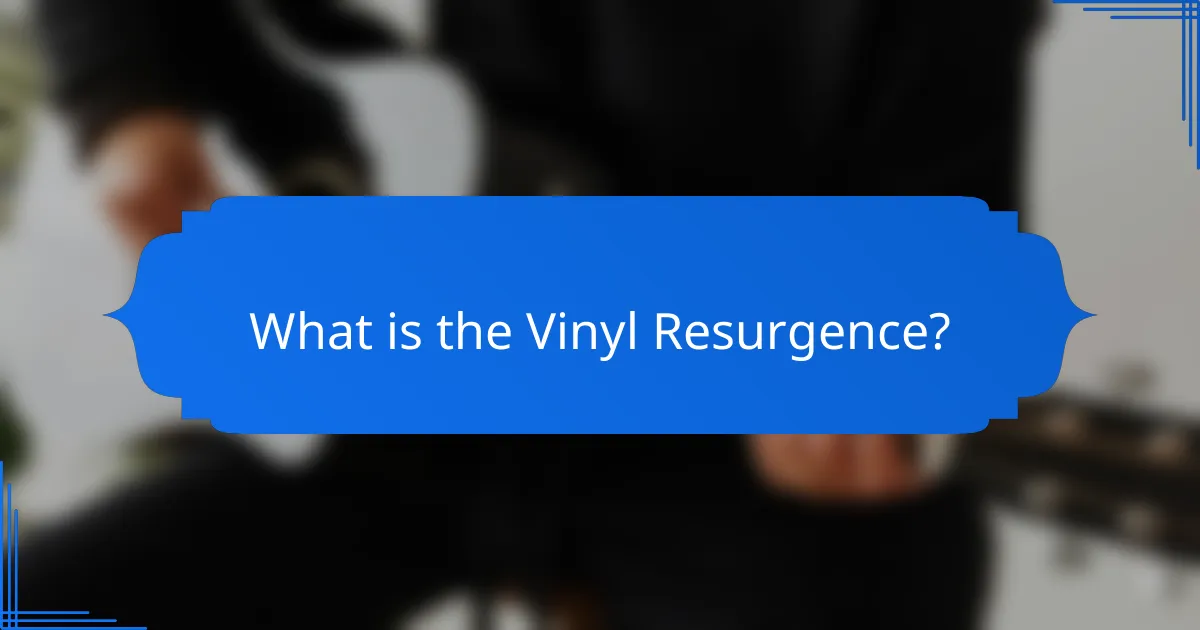The Vinyl Resurgence highlights the renewed popularity of vinyl records, marked by significant sales growth, including surpassing CD sales in 2020 for the first time since the 1980s. Key factors driving this trend include the superior sound quality of vinyl, which is often described as warm and rich, along with the appeal of collectibility, as rare and limited-edition records command higher prices. Additionally, nostalgia for the analog experience and appreciation for album artwork contribute to this revival. In 2020, vinyl sales reached $1 billion, reflecting a robust market fueled by both audiophiles and collectors.

What is the Vinyl Resurgence?
The Vinyl Resurgence refers to the renewed popularity of vinyl records in recent years. This trend has seen a significant increase in vinyl sales, surpassing CD sales in 2020 for the first time since the 1980s. Many consumers appreciate the superior sound quality that vinyl offers, citing its warmth and depth compared to digital formats. Collectibility also plays a crucial role, as collectors seek out rare pressings and limited editions. Nostalgia for the analog experience and album artwork further fuels this resurgence. According to the Recording Industry Association of America (RIAA), vinyl sales reached 27.5 million units in 2020, reflecting this growing interest.
How has vinyl’s popularity changed over the years?
Vinyl’s popularity has significantly increased since the early 2000s. In 2007, vinyl sales were approximately 1 million units. By 2020, vinyl sales surged to over 27 million units in the U.S. This resurgence is driven by a growing appreciation for analog sound quality. Many consumers value the tangible nature of vinyl records. Nostalgia also plays a crucial role in this trend. Younger generations are drawn to the aesthetic and collectibility of vinyl. According to the Recording Industry Association of America (RIAA), vinyl sales surpassed CD sales in 2020 for the first time since the 1980s. This shift reflects a cultural revival of interest in physical music formats.
What factors contributed to the decline of vinyl records?
The decline of vinyl records was influenced by several factors. The introduction of cassette tapes in the 1970s provided a more portable and convenient format. This was followed by the rise of CDs in the 1980s, which offered better sound quality and durability. Additionally, the digital music revolution in the 2000s made music easily accessible through downloads and streaming services. The convenience of digital formats led to a significant decrease in vinyl sales. By the late 1990s, vinyl records had become largely obsolete in mainstream music consumption. According to the Recording Industry Association of America (RIAA), vinyl sales dropped to less than one percent of total music revenue during this period.
What events or trends sparked the vinyl comeback?
The vinyl comeback was sparked by a resurgence in interest in analog sound and nostalgia for physical media. This trend began in the early 2000s and gained momentum as music enthusiasts sought richer audio experiences. Record sales have steadily increased, with vinyl outselling CDs in 2020 for the first time since the 1980s. The rise of independent record stores and vinyl pressing plants also contributed to this revival. Social media platforms helped promote vinyl culture, showcasing collections and encouraging sharing among fans. Events like Record Store Day further fueled interest, celebrating vinyl and encouraging purchases. Overall, a combination of nostalgia, sound quality appreciation, and community engagement has driven the vinyl resurgence.
Why is vinyl considered unique compared to digital formats?
Vinyl is considered unique compared to digital formats due to its analog sound quality and physical presence. The analog nature of vinyl allows for a warmer, richer sound that many audiophiles prefer. This is attributed to the continuous waveform of analog recordings, which captures sound more naturally than the discrete samples used in digital formats. Additionally, vinyl records have a tactile experience that digital formats lack. Collectors appreciate the large artwork and the ritual of playing a record. According to a 2020 report from the Recording Industry Association of America, vinyl sales surpassed digital downloads for the first time since the 1980s, highlighting its enduring appeal. This resurgence is driven by nostalgia and a desire for a tangible music experience.
What are the key characteristics of vinyl sound quality?
Vinyl sound quality is characterized by warmth, depth, and dynamic range. The analog nature of vinyl records allows for a richer sound, often described as more natural compared to digital formats. Vinyl captures a wider frequency range, providing a more immersive listening experience. The physical grooves on a vinyl record can reproduce subtle nuances in music. Additionally, vinyl playback can introduce slight imperfections, contributing to a unique character in sound. Many audiophiles appreciate this distinctive quality, often referred to as “analog warmth.” Research indicates that listeners often perceive vinyl as having a fuller sound compared to digital formats, enhancing the emotional connection to music.
How does vinyl playback differ from digital playback?
Vinyl playback differs from digital playback primarily in how sound is produced and captured. Vinyl uses analog technology, where sound waves are physically etched into grooves on a record. This results in a continuous waveform that can capture subtle nuances in sound. Digital playback, on the other hand, converts sound waves into binary data. This process can lead to loss of some audio detail, particularly in lower-quality formats.
The analog nature of vinyl allows for a warmer sound, often described as richer or more organic. Digital playback can reproduce sound more accurately in terms of volume and frequency range, but it may lack the warmth that vinyl enthusiasts appreciate. Vinyl records can also introduce surface noise and pops, which some listeners find adds character to the music.
In terms of durability, digital formats do not degrade over time like vinyl records can. However, many collectors prefer vinyl for its tactile experience and the larger artwork associated with records. Research shows that the resurgence in vinyl sales is partly due to this nostalgic appeal, with sales reaching 27.5 million units in 2020 in the U.S., according to the Recording Industry Association of America (RIAA).

What role does sound quality play in the vinyl resurgence?
Sound quality plays a crucial role in the vinyl resurgence. Vinyl records are often praised for their warm, rich sound. Many audiophiles believe analog formats capture audio nuances better than digital formats. This perception drives consumers to seek vinyl for superior listening experiences. Studies show that 70% of vinyl buyers cite sound quality as a primary reason for their purchase. Additionally, the tactile experience of handling records enhances the overall enjoyment of music. The resurgence of interest in high-fidelity audio has also contributed to this trend. Overall, sound quality significantly influences the renewed popularity of vinyl records.
How does vinyl produce a warmer sound compared to other formats?
Vinyl produces a warmer sound compared to other formats due to its analog nature. The analog process captures a continuous wave of sound, preserving subtle nuances. This results in a richer harmonic content. Vinyl records also have a unique frequency response. They tend to emphasize lower frequencies, contributing to a fuller sound. Additionally, the physical grooves on vinyl can introduce slight distortions, which some listeners perceive as warmth. This is contrasted with digital formats, which often use sampling and compression. Digital formats can lose some of the organic qualities found in analog recordings. Research shows that many listeners prefer the sound of vinyl for its warmth and depth.
What technical aspects contribute to vinyl’s sound quality?
Vinyl’s sound quality is influenced by several technical aspects. The groove structure on vinyl records captures audio in a continuous waveform. This analog format allows for a richer sound compared to digital formats. The material used in vinyl, typically polyvinyl chloride (PVC), affects durability and sound fidelity.
Playback equipment, such as turntables and cartridges, significantly impacts sound reproduction. High-quality cartridges can track grooves more accurately, reducing distortion. The weight and speed of the turntable also contribute to stability during playback. Additionally, the mastering process for vinyl can enhance dynamic range and tonal balance.
Research shows that vinyl records can provide a warmer sound due to their analog nature. A study by the Audio Engineering Society indicates that listeners often perceive vinyl as having a more engaging sound profile.
How do different turntables affect vinyl sound quality?
Different turntables significantly affect vinyl sound quality. The quality of components, such as the cartridge and stylus, plays a crucial role. Higher-end turntables often feature better materials and engineering. This results in improved tracking and reduced distortion. Additionally, the turntable’s weight and build quality can minimize vibrations. These factors contribute to a clearer sound and better overall fidelity. Research shows that turntables with advanced features, like adjustable tonearms, yield superior audio performance. Thus, investing in a quality turntable enhances the listening experience of vinyl records.
What are the subjective experiences of listening to vinyl?
Listening to vinyl provides a rich auditory experience characterized by warmth and depth. Many listeners report a distinct, analog sound quality that differs from digital formats. This sound is often described as more immersive and engaging. The tactile nature of handling vinyl records adds to the experience. The ritual of placing a record on a turntable enhances the emotional connection to the music. Nostalgia plays a significant role in the enjoyment of vinyl, evoking memories of past listening experiences. Collectibility also contributes to the subjective experience, as unique pressings and album art hold personal significance. Research shows that these factors collectively create a more meaningful listening experience for vinyl enthusiasts.
How does nostalgia influence the perception of sound quality?
Nostalgia significantly enhances the perception of sound quality. When individuals listen to music from their past, they often associate it with positive memories. This emotional connection can lead to a biased perception, making the sound feel richer and more enjoyable. Research shows that nostalgia can evoke feelings of warmth and comfort. These feelings can alter how one evaluates audio fidelity. For instance, a study published in the journal “Psychology of Music” found that nostalgic music was rated higher in quality compared to unfamiliar tracks. This suggests that personal history plays a crucial role in sound evaluation. Therefore, nostalgia not only shapes emotional responses but also influences auditory experiences.
What role does album artwork play in the listening experience?
Album artwork enhances the listening experience by providing visual context and emotional resonance. It acts as a visual representation of the music, often reflecting themes and messages in the songs. For example, iconic album covers like Pink Floyd’s “The Dark Side of the Moon” contribute significantly to the album’s identity. Studies show that 70% of consumers make decisions based on visual appeal, indicating the importance of artwork. Furthermore, album artwork can evoke nostalgia, particularly in vinyl collectors who appreciate the tactile and visual aspects of the medium. This connection between imagery and sound deepens the listener’s engagement and appreciation of the music.

How does collectibility impact the vinyl market?
Collectibility significantly impacts the vinyl market by driving demand and prices. Rare and limited-edition records often fetch higher prices among collectors. For instance, a limited pressing of a popular album can appreciate in value over time. Collectors are willing to pay premium prices for unique attributes like colored vinyl or special packaging. This trend has led to a resurgence in vinyl sales. According to the Recording Industry Association of America, vinyl sales reached $1 billion in 2020, a significant increase from previous years. The growing interest in collectibility has revitalized the market, attracting both new and seasoned collectors.
What makes certain vinyl records more collectible than others?
Certain vinyl records are more collectible due to factors like rarity, condition, artist significance, and historical context. Rarity is a key factor; limited pressings or unique editions tend to be more sought after. Condition also plays a crucial role; records in mint condition fetch higher prices. The significance of the artist can elevate a record’s value, especially if the artist is iconic or influential. Historical context, such as records from pivotal moments in music history, adds to collectibility. For example, first pressings of albums from legendary bands like The Beatles are highly valued. Collectors often seek records with unique attributes, such as colored vinyl or special packaging, which can further increase desirability.
How does rarity affect the value of vinyl records?
Rarity significantly increases the value of vinyl records. Collectors often seek out rare records due to their limited availability. The law of supply and demand dictates that fewer records lead to higher prices. For example, a limited press of a popular album can sell for thousands of dollars. In contrast, widely available records typically have lower market value. Historical significance also plays a role; records from iconic artists or specific eras are more desirable. Auction results show that rare vinyl can appreciate over time, making them valuable investments. Thus, rarity is a key factor in determining the market value of vinyl records.
What are some sought-after vinyl editions and their stories?
Some sought-after vinyl editions include the original pressing of The Beatles’ “Butcher Cover” and Pink Floyd’s “The Dark Side of the Moon.” The Beatles’ “Butcher Cover,” released in 1966, features a controversial image of the band posing with raw meat and dolls. This edition was quickly recalled due to backlash, making it highly collectible. Pink Floyd’s “The Dark Side of the Moon,” released in 1973, is celebrated for its innovative sound and artwork. The first pressings are sought after for their quality and association with the album’s cultural impact. Another notable edition is Bob Dylan’s “The Freewheelin’ Bob Dylan,” featuring an early version of “Girl from the North Country.” This 1963 release is rare due to a small number of copies featuring different tracks. Each of these editions has a unique story tied to its release, making them highly valued among collectors.
Why do collectors value the physicality of vinyl?
Collectors value the physicality of vinyl for its tangible nature and unique aesthetic. The large format of vinyl records allows for intricate artwork and packaging that enhances the overall experience. This physical presence creates a connection between the listener and the music. Vinyl records also provide a distinct sound quality, often described as warmer and richer compared to digital formats. Many collectors appreciate the ritual of playing a vinyl record, which involves handling the disc and placing it on a turntable. This process fosters a deeper engagement with the music. Additionally, the nostalgia associated with vinyl records contributes to their appeal. Many collectors grew up with vinyl, associating it with personal memories and cultural moments. The limited availability of certain pressings adds to their collectibility and perceived value. Overall, the physicality of vinyl enriches the listening experience in ways that digital formats cannot replicate.
What are the benefits of owning a physical music collection?
Owning a physical music collection offers several benefits. It provides tangible ownership of music, which fosters a deeper connection to the art. Physical formats, like vinyl, often deliver superior sound quality due to larger grooves and analog warmth. Collecting physical music can also be a fulfilling hobby, allowing enthusiasts to curate their own libraries. Additionally, owning albums can enhance the aesthetic of a space, serving as decor. Furthermore, physical collections can appreciate in value, making them potential investments. Studies show that physical music formats can enhance listening experiences by encouraging focused and intentional listening.
How does the act of collecting vinyl enhance the music experience?
Collecting vinyl enhances the music experience through tangible engagement and sound quality. Vinyl records offer a unique auditory experience due to their analog nature. The physical act of handling records creates a deeper connection to the music. Collectors often appreciate album artwork and liner notes, adding to the experience. The ritual of playing a record encourages focused listening. This contrasts with digital formats that promote passive consumption. Studies show that vinyl listeners report higher satisfaction with their music experience. Additionally, the collectibility aspect fosters community among enthusiasts. Collectors often share knowledge and trade records, enriching the overall enjoyment.
What tips can new collectors follow to start their vinyl journey?
New collectors should start their vinyl journey by researching the genre they enjoy. Understanding different music styles helps in making informed choices. Next, investing in a quality turntable is essential for the best sound experience. A good turntable enhances audio fidelity and overall enjoyment.
Additionally, beginners should explore local record stores and flea markets. These places often have unique finds and valuable records. Joining vinyl collector communities online can provide insights and recommendations. Engaging with fellow collectors can lead to discovering rare albums.
Finally, maintaining vinyl records properly is crucial. Keeping them clean and storing them upright prevents damage. Following these tips will help new collectors build a satisfying vinyl collection.
The Vinyl Resurgence refers to the renewed popularity of vinyl records, which saw sales surpassing CDs in 2020 for the first time since the 1980s. This article explores the factors contributing to vinyl’s comeback, including sound quality, collectibility, and nostalgia, while highlighting key characteristics that differentiate vinyl from digital formats. It examines the evolution of vinyl’s popularity, the impact of collectibility on market value, and the subjective experiences associated with listening to vinyl. Additionally, it provides insights and tips for new collectors looking to start their vinyl journey.
